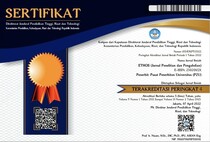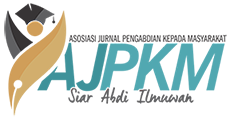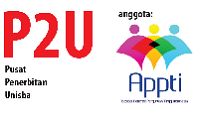PENINGKATAN NILAI TAMBAH KOMODITAS PERKEBUNAN PETANI KOPI ORGANIK DI DESA SRIMENANTI LAMPUNG BARAT
Abstract
West Lampung Regency is a regency in Lampung Province with the main livelihood of its people as farmers. West Lampung regency has plantation area of 65,211.8 Ha with three superior commodities namely robusta coffee, pepper and cocoa. Nationally, coffee, pepper and cocoa commodities are also national commodities whose production increase will be prioritized for the purpose of foreign exchange earnings / exports. Srimenanti village is one of the villages in the subdistrict of Air Hitam, with land area for settlements, plantations, and rice fields. The selection of Desa Sri Menanti because this village has potential for plantation and has potential for the development of plantation products in order to increase the capacity and economy of the community, but also the community is warm to receive renewal in terms of environmentally friendly technology. Increased farmers' income, especially coffee cultivators do not seem to be able to improve welfare. This is because coffee farmers just sell their products to distributors. Strategic efforts of all stakeholders are needed to increase the income of existing coffee farmers and develop enough in Lampung. The prospect of plantation commodity is very big, processed into canned food such as organic coffee powder, organic coffee powder with additional fruit flavor, durian, stroberry and others, various processed banana chips, jam etc. Products from vegetables such as dodol squash, tomato dodol. This is so that all existing potentials can be managed to the maximum and boost the economy and progress of this village.
Keywords
Full Text:
PDFReferences
AAK. 1998. Bertanam Pohon Buah-buahan. Kanisius. Yogyakarta
Anonim, 2016. Perkebunan. Pemerintah Kabupaten Lampung Barat. http://lampungbaratkab.go.id/program-unggulan/perkebunan/
Ashari, Semeru. 1995. Holtikultura Aspek Budidaya. Universitas Indonesia Press
(UI-Press). Jakarta
Badan Agribisnis Departemen Pertanian. 1999. Investasi Agribisnis Komoditas Unggulan Tanaman Pangan dan Holtikultura. Kanisius. Yogyakarta.
Badan Pusat Statistik Kabupaten Lampung Barat. 2015. Lampung Barat dalam Angka 2013. Katalog BPPS 1102001.1801.
E.W.M., Verheij & R.E. Coronel. 1997. Sumber Daya Nabati Asia Tenggara II; Buah-buahan Yang Dapat Dimakan. PT. Gramedia Pustaka Utama dan Prosea Indonesia & European Commission. Jakarta.
Hatimah, Ihat .2006. Pengelolaan Pembelajaran Berbasis Potensi Lokal di PKBM. Mimbar Pendidikan. No. 1/XXV/.
Journal. Makara Seri Teknologi . ISSN 1693-6698, Volume16; Issue: 1; 63 UI Jakarta
Natawidjaja, P. Suparman. 1983. Mengenal Buah-buahan yang Bergizi. Pustaka Dian. Jakarta.
Rukmana, Rahmat. 1996. Nanas Budidaya dan Pascapanen. Kanisius. Yogyakarta.
Sutanto Agus. 2011. Nata de Pina Dari Limbah Cair Nanas. UMM Press: Malang.
Sutanto, Agus. 2011. Bioremidiasi Limbah Cair nanas sebagai Bahan Baku Pembuatan nata de pina. Hasil Penelitian tidak dipublikasikan laboratorium biologi.
Sutanto, Agus.2012. Pineapple Liquid Waste As Nata De Pina Raw Material.
Syukur, M. Sahat, Bambang, I dan Achmad, S 1987 Analisis Biaya Keuntungan Usaha Penangkapan Ikan skala Kecil di Langkat Sumatra Utara. Forum Penelitian Agroekonomi Vol 5 No 1 dan 2 Desember 1987. Pusat Penelitian Agro Ekonomi Badan Penelitian dan Pengembangan Pertanian Departemen Pertanian Bogor.
Tjitrosoepomo, Gembong. 2003. Taksnonomi Spermatophyta. UGM Press: Yogyakarata
Yoseph M. Laynurak. 2008. Model Diversifikasi Usaha Masyarakat Pesisir dan Implikasinya Terhadap Kesejahteraan Serta Kelestarian Sumber Daya Wilayah Pesisir Di Kabupaten Belu-NTT. Program Pasca Sarjana Universitas Diponegoro Semarang.
DOI: https://doi.org/10.29313/ethos.v6i1.3232
Refbacks
- There are currently no refbacks.
Alamat Redaksi:
LPPM Unisba, Lantai 2, Jl. Purnawarman 63, Bandung 40116, Jawa Barat, (022) 4203368 , (022) 4264064. ethos.unisba@gmail.com / ethos@unisba.ac.id

This work is licensed under a Creative Commons Attribution-NonCommercial-ShareAlike 4.0 International License.














